Learning
HSC Showcase: Textiles 2023
Class of 2023 HSC Major Work in Textiles
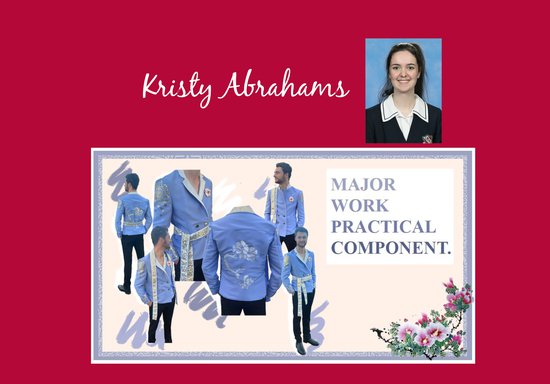
Kristy Abrahams
My Major Textiles Project design is a textiles costume piece and is intended for use in a K-pop music video dance performance.
Inspiration for the design derives from the cultural elements of South Korea, defined by the modern sub-culture of K-pop costuming. The inclusion of traditional inspired techniques such as geumbak (gold leaf stamping) and traditional symbols of longevity, represent aspects of cultural spirituality. These symbols are specifically present within Korean costuming thereby reminding the audience that the performer is a representation of their culture, through the medium of music and dance.
The repetition of the mugunghwa flower motif in the stumpwork and laser-cut element reflects aspects of the cultural inspiration. This symbol is an object of deep affection within the Korean culture as it represents the 'eternal blossom that never fades', and has been an important symbol of Korean culture for centuries.
Furthermore, a major cultural aspect of South Korea I have been inspired by is the traditional garment of Korea, the hanbok. The Korean hanbok was designed to facilitate ease of movement and the design features have remained relatively unchanged to the present day. The basic aesthetic framework of all hanbok is centred around the Korean fondness for nature. This has been captured with my own design, through the construction of a cross-over neckline and an added belt element to the garment.
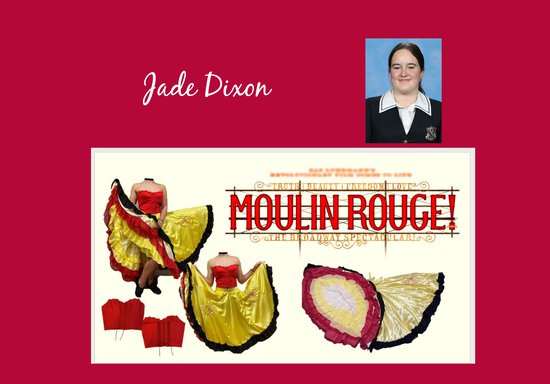
Jade Dixon
The Contemporary film ‘Moulin Rouge’ 2001, directed by Baz Luhrmann inspired the garment for this project. The ‘Diamond Dogs’ in the film are the cancan dancers and their dresses used in traditional cancan dancing acted as the foundation for this piece. I specifically designed this garment for Nini-Legs-In-The-Air so her character and costumes were taken into consideration. Nini-Legs-In-The-Air is the main cancan dancer of the ‘Diamond Dogs’ and is considered to be the antagonist to the protagonist Sateen. In the film she has a secret romance and is depicted as very jealous and spiteful. This is reflected through her colour scheme in the film, her costumes consist of mostly red, yellow, and black to symbolise the romance, and hatred she feels throughout the film. The dark reds reflect her character at the beginning of the film and the yellow symbolises her character development and growth towards the closing of the film. All while creating an extremely harmonious and aesthetically pleasing finished product.
The architecture of the building, topped by a giant windmill, where cancan dancing originated from, was part of the inspiration for this costume. The windmill shape was utilised in this costume as it stands out and acts as a focal point. The windmill sails are made up of many smaller intersecting lines and crosses that create a much more intricate pattern. This detail was integrated into a costume through fabric manipulation and patterns.
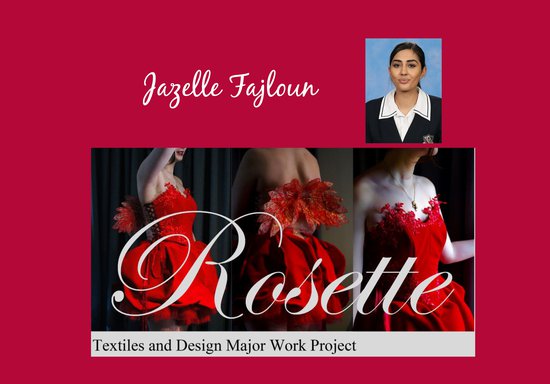
Jazelle Fajloun
The ballerina costume, Rosette, is a homage to the act of selfless love, the courage of the voiceless and the beauty found within everyday moments. Featuring complex techniques of lace applique, that elegantly caress the ballerina figure on the sculpted silhouette corset, juxtaposed to the voluminous, flourishing, layered skirt. The strapless sweetheart neckline features the feminine decolletage representing the purity of an everlasting rose. The vivacious skirt is finely cut and shaped into rose petals, structured with 20-gauge wire, layered with soft bridal tulle to fulfill the aesthetic of a flourishing rose when danced in. The fairy-tale costume models fashion and female empowerment, as it embraces the culture of ballet and the art of sophisticated storytelling. The double-sided corset with double layered satin ribbon gather the skirt and secure the costume. Transformation is apparent in the back of the corset, where the subtle wings of a swan, achieved through free hand machine embroidery, unites the costumes captivating spirit. Reflecting this delicate balance an ethereal colour palette of rich, regal, royal red, is textured through the fabrics, materials, and manipulation on the ballerina costume. The architectural inspired symmetry defines perfection, as the applique and petalled skirt are repeated.
The exotic textures: lace, tulle and velvet are embellished through the rich colour red inspired by an everlasting pure red rose. The ballerina costume can be paired with a red lace up pointe shoe as its infant beauty is displayed on stage. The desirable features of the costume are especially designed to complement the interior architecture of the palais Liechtenstein. The romantic tranquillity of the item displays a deep story of passion, transformation through sacrifice and the beauty of freedom. The rouleau loops allow an easy access adjusting to any size, achieving functional design. Thus, the end use for the ballerina costume is to be functional and aesthetic for dance in theatre production.
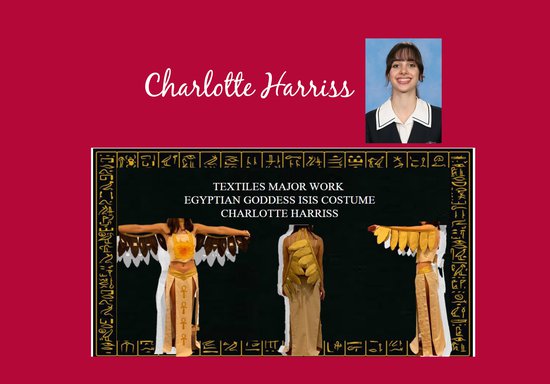
Charlotte Harriss
My major project is a costume intended to be used for a stage production based off the novel 'Call me Isis'.
My major project was inspired by the Egyptian goddess, Isis. Specifically, her large wings and the sun disk and horns often depicted on her head. Her name was translated to 'Queen of the throne' and she was often seen as a mother to all obtaining qualities of being magical and a healer. Other aspects of ancient Egyptian culture that have inspired me include hieroglyphics and the ankh symbol. I am also inspired by Colleen Atwood's designs especially those that feature large shoulder features and strong waistlines. Often used in the costumes of powerful characters in many films.
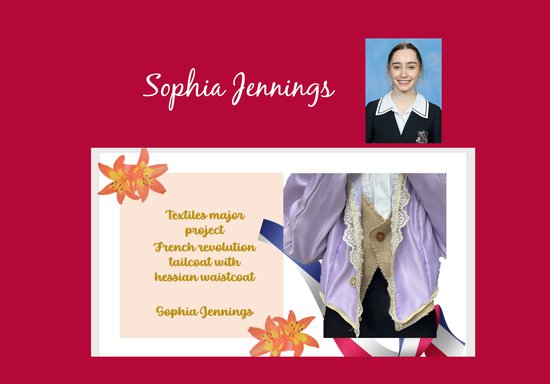
Sophia Jennings
The focal inspiration for my design's stems from the French Revolution, aristocratic fashion with a modern, political twist, and the Louis Vuitton SPRING 2018 ‘Ready-to-wear’ runway collection. Louis Vuitton’s Spring 2018 collection, as well as the historical late 18th-century style tailcoat and waistcoat, are my key inspiration for my garment. The focus area for my major project garment is Costume, to be worn at glamourous gala events, with themes such as ‘historical representation’ and ‘old-style glam’, its main purpose is to be worn to gatherings or events that exhibit highly decorative and statement pieces such as the Met Gala ceremony, formally called the Costume Institute Gala or the Costume Institute Benefit, it is an annual fundraising gala held for the benefit of the Metropolitan Museum of Art's Costume Institute in New York City, where extravagant and flamboyant outfits are encouraged. The garment’s intricate French flag ribbon detail on the back, as well as the flower print and satin lavender purple material, indicates that this garment is intended to be worn by females but can be worn by all genders. Features that strengthen my garment design functionally, include the singular button-up closure method on the inner waistcoat. The garment’s highly decorative and intricate artwork screen printed floral design featured on the back of the tailcoat piece of the garment is both a statement and political representation of the contrast between the way of life of the aristocrats to the people suffering from poverty. The juxtaposition of the tailcoat and waistcoat being worn by males during the 18th century and the design of the garment being for women plays along to the main purpose of my garment to create a stir.
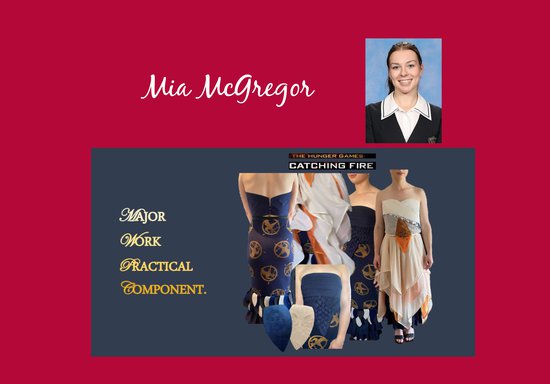
Mia McGregor
This garment is a two-layer costume derived from the main contemporary influence of the 2013 Action/Sci-fi film, The Hunger Games: Catching fire. Further elements of this design have been drawn from the intricate techniques of modern designers Trish Summerville and Tex Saverio (Rio). The end use of this costume is for a Broadway stage production of The Hunger Games the Musical. Additional aspects of the costume have been inspired by Balenciaga’s 1950’s evening gown line, and Daisy Edgar Jones’ 2023 Gucci Golden Globes dress. Through visual representation, costumes serve the purpose of bringing a fictional character to life. Costumers create an illusion that contributes to the overall atmosphere and mood of the performance, playing a crucial role in telling the story.
Aesthetic aspects of the design that achieve this purpose include the embellishments of Mockingjay symbols, a primrose flower, and the feathered representation of a mocking jays wings. Functional aspects of this costume design that strengthen its purpose include the utilisation of Velcro and press studs, to ensure that layers can quickly be removed. In further expressing the musicals storyline, soft, delicate edges have purposefully been used on the first layer of the costume, to represent the innocent, and clam nature of the protagonist, Katniss Everdeen, and society prior to the detrimental, fight to the death event that was the Hunger Games.
To display the corruption that resulted from the games, the second layer utilises sharp edges, and dark colours. These design features encourage audiences to engage in the feelings and emotions of the character, enhancing their experience. Additionally, lustre and shape have been incorporated into the design demonstrating the principals of both emphasis and movement. This is achieved through the handkerchief hem of the first layer’s skirt, in which a lustrous orange lining has been used to both engage viewers and distract them from the costumes transformation. The drape of the hem also allows for the top layers to rise when spun, revealing the second layer below. Finally, the top layer of the costume utilises sheer fabrics of organza and chiffon, to purposefully allow certain aspects of the layer beneath to be shown. In doing so, these transparent aspects act as a symbolic representation of the fire and determination that is within Katniss.
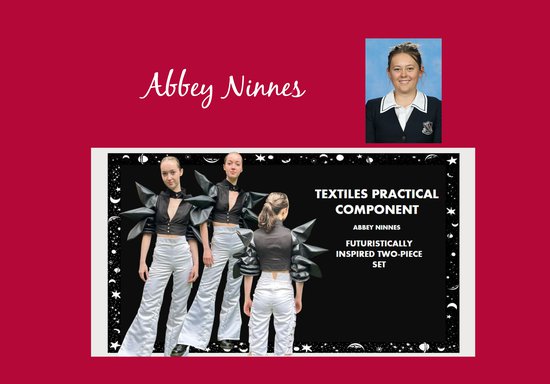
Abbey Ninnes
My garment is a futuristically inspired two-piece top and pant set. The design is inspired by contemporary designer Iris Van Herpen's notion of idiosyncratic designs that defy normality and represent unconventionality. The garment is to be worn by 38-year-old Iris Van Herpen, in a gala setting, to commemorate women's power and autonomy in different fields and workforces. Additionally, I was inspired by the Japanese samurai, and their power and toughness represented through their role, but mirrored in their garments. Ultimately, I have included this through the sharpness and dimension of the sleeves. The garment features white flared pants, that are innovative and create an elongating effect on the silhouette. Down the sides of the pants, there is a fabric folding manipulation technique that utilises folded white fabric downwards, leaving triangular gaps between each fold as they cascade down the legs, ultimately establishing contrast. The high neck design, secured with buttons at the front, opens at the front of the garment and is worn like a vest. The centre front of the garment is open revealing the skin, which contradicts the traditional Japanese notion of conservatism. The sleeves are dimensional, and sharp in nature, ultimately creating interest and salience, but are innovative. The unique design of the sleeves is new to the market and creative. The garments seek to represent high fashion and sophistication, ultimately mirrored throughout the monochromatic black and white colour pallet, and the brushed satin pants that exude a sense of sophistication, and the lustre of the top creating a high-quality appearance.
Iris Van Herpen creates garments that are characterised as haute couture, ultimately establishing dimension, and representing a futuristic and fantastical aesthetic. I have utilised Van Herpen's unconventional sillhouette through the sleeves of my design that cascades down the arm, allowing me to fuse fashion with futurism. In addition, Van Herpen utilises the notion of female sexuality and power, by utilising the exposure of the female body in conjunction with the structure and masculine form that manipulates the silhouette. The notion of power and authority represented by the warriors of premodern Japan has inspired the sleeves of the garment and depicted through the heavy and bulky appearance of leather being symbolic of the samurai's protective armour.





